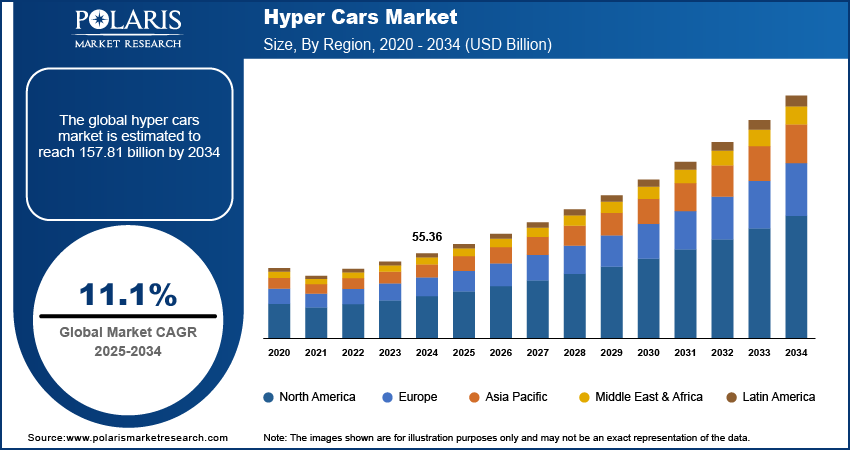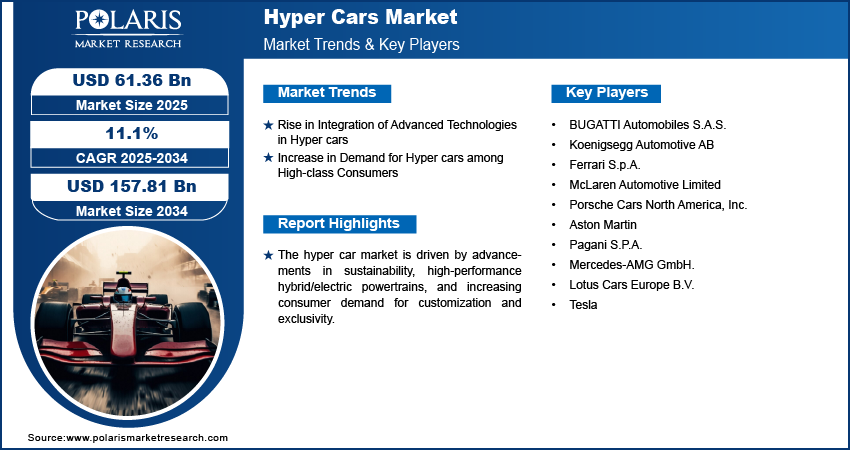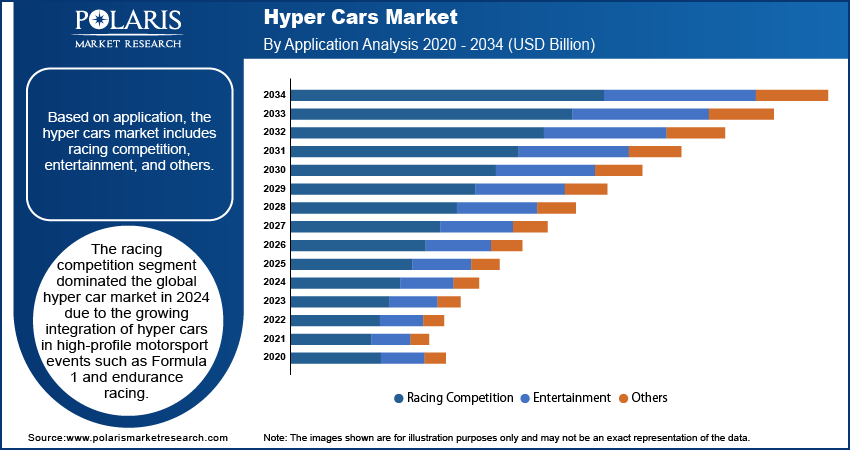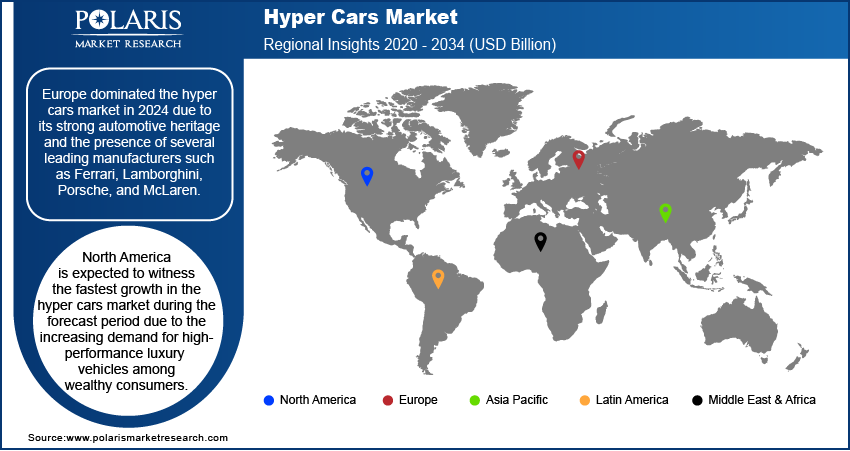
Hyper Cars Market Size, Share, Trends, Industry Analysis Report: By Propulsion (ICE Vehicle, Electric Vehicle, and Hybrid Vehicle), Application, and Region (North America, Europe, Asia Pacific, Latin America, and Middle East & Africa) – Market Forecast 2025–2034
- Published Date:Feb-2025
- Pages: 128
- Format: PDF
- Report ID: PM1655
- Base Year: 2024
- Historical Data: 2020-2023
Hyper Cars Market Overview
The hyper cars market size was valued at USD 55.36 billion in 2024. The market is projected to grow from USD 61.36 billion in 2025 to USD 157.81 billion by 2034, exhibiting a CAGR of 11.1% during the forecast period.
Hyper cars are high performance, ultra-luxury vehicles that combine advanced technology, extreme speed, and exclusive design, often featuring advanced powertrains, lightweight materials, and exceptional engineering. They are typically produced in limited quantities and cater to an elite clientele.
The hyper cars market is a niche segment of the automotive industry, characterized by ultra-high-performance vehicles that combine advanced technology, luxury, and exclusivity. These cars are often limited in production and priced at a premium, catering to wealthy clients. Key players in the market, such as Ferrari, Bugatti, McLaren, and Porsche, continually push the boundaries of engineering, offering top speeds, advanced aerodynamics with air deflectors, and ground-breaking powertrains, including hybrid and electric models. For instance, in December 2024, Genesis unveiled its entry into motorsport with the launch of Genesis Magma Racing in Dubai, highlighting its ambitions in endurance racing and commitment to innovation and performance. The market has seen increased interest in sustainable high-performance vehicles, with manufacturers exploring electric propulsion and alternative fuel technologies. Additionally, hyper cars serve as a showcase for automotive innovation, influencing mainstream automotive design. As a result, the market is expected to grow steadily, driven by wealthy consumer's desire for exclusivity, innovation, and speed.

To Understand More About this Research: Request a Free Sample Report
Hyper Cars Market Dynamics
Rise in Integration of Advanced Technologies in Hyper Cars
The integration of advanced technologies in hyper cars is a key driver of hyper cars market growth, as it improves performance, safety, and user experience, appealing to high-end consumers. Innovations such as lightweight materials, active aerodynamics, advanced driver-assistance systems (ADAS), and hybrid or electric powertrains push the limits of engineering and sustainability. For instance, in October 2024, Ferrari launched the F80 hyper car, featuring its first-ever 800V hybrid system paired with a V6 engine and 48V electric turbochargers. Inspired by Formula 1, the design enhances turbine efficiency and responsiveness. The hyper car also integrates a carbon-fiber chassis for weight reduction and an adaptive rear wing for optimized aerodynamics based on driving conditions. These advanced features improve speed and efficiency and also set benchmarks for the automotive industry. Furthermore, advancements in connectivity and customization options cater to the demand for exclusivity and modern luxury. It fuels consumer interest, solidifying hyper cars as symbols of innovation and prestige as technology continues to evolve.
Increase in Demand for Hyper Cars among High-Class Consumers
The growing demand for hyper cars among high-class consumers is a driver of the market, driven by their desire for exclusivity, advanced technology, and unmatched performance. Hyper cars serve as status symbols, appealing to affluent buyers seeking luxury and innovation. The limited production runs and bespoke customization options further enhance their allure. Additionally, the rise of sustainable hyper cars, incorporating advanced hybrid and electric powertrains, resonates with environmentally conscious consumers. For instance, in March 2023, Lamborghini launched the Revuelto, a hybrid hyper car combining a V12 engine with three electric motors and a lithium-ion battery. Delivering 1015 horsepower, it features multiple driving modes for optimized energy efficiency. Its carbon-fiber monocoque chassis enhances performance while reducing weight, highlighting a shift toward more sustainable hyper car designs. The increasing interest among the elite boosts the hyper cars market, encouraging manufacturers to innovate and cater to this niche segment continually.

Hyper Cars Market Segment Analysis
Hyper Cars Market Assessment by Propulsion Outlook
The global hyper cars market segmentation, based on propulsion, includes ICE vehicle, electric vehicle, and hybrid vehicle. The electric vehicle (EV) is the fastest-growing segment due to increasing consumer demand for high-performance, environmentally friendly options. EV hyper cars offer zero-emission technology, aligning with global sustainability trends and stricter emissions regulations. The adoption of advanced battery technologies, such as solid-state and lithium-ion batteries, further enhances performance and range, making EV hyper cars more appealing. Additionally, leading automakers are investing heavily in electric propulsion to meet consumer interest in luxury, innovation, and eco-friendliness.
Hyper Cars Market Evaluation by Application Outlook
The global hyper cars market segmentation, based on application, includes racing competition, entertainment, and others. The racing competition segment dominated the market in 2024 due to the growing integration of hyper cars in high-profile motorsport events such as Formula 1 and endurance racing. These vehicles are designed to push the boundaries of performance with advancements in aerodynamics, powertrains, and materials. Motorsport organizations prioritize advanced technology, which drives innovation in the hyper car industry. The demand for hyper cars in racing also supports the growth of high-performance, limited-edition models, further boosting the hyper cars market growth.

Hyper Cars Market Regional Insights
By region, the study provides hyper cars market insights into North America, Europe, Asia Pacific, Latin America, and the Middle East & Africa. Europe dominated the market in 2024 due to its strong automotive heritage and the presence of several leading manufacturers such as Ferrari, Lamborghini, Porsche, and McLaren. The region has established itself as a hub for innovation in high-performance vehicles, with a focus on advanced technology, luxury, and design. Additionally, Europe's strict environmental regulations are driving the development of more sustainable hyper cars, including electric and hybrid models. For instance, in November 2024, Porsche launched the second-generation Taycan, featuring enhanced power, range, and faster charging. The lineup now includes the Taycan 4 sports sedan, Taycan GTS, and Taycan GTS Sport Turismo. The upgrade includes an 80 kW more powerful motor, improved thermal management, and up to 320 kW DC charging. The models also offer increased recuperation power and enhanced efficiency. The strong motorsport culture and numerous prestigious events also contribute to Europe's dominance in the market.
North America is expected to witness the fastest growth in the hyper cars market during the forecast period due to increasing demand for high-performance luxury vehicles among affluent consumers. The region's strong automotive industry, along with the presence of major manufacturers and technological innovations, contributes significantly to this growth. Furthermore, North America's early adoption of electric and hybrid vehicles, driven by environmental awareness and regulatory incentives, accelerates the development of sustainable hyper cars. Additionally, a rising interest in motorsport and automotive events further fuels demand.

Hyper Cars Market – Key Players and Competitive Analysis Report
The competitive landscape of the hyper cars market is defined by global leaders and niche players aiming to capture market share through advanced technology, innovation, strategic partnerships, and regional expansion. Major global brands such as Bugatti, Koenigsegg, Ferrari, McLaren, and Porsche leverage their expertise in engineering, design, and performance to offer high-performance, exclusive vehicles. Market trends show rising demand for hyper cars with hybrid and electric powertrains, as well as advancements in aerodynamics, lightweight materials, and autonomous driving features. According to industry projections, the hyper cars industry is poised for substantial growth, driven by increasing consumer interest in luxury, speed, and technological advancements. Regional players capitalize on the demand for high-performance cars by introducing tailored models suited to local tastes, particularly in markets such as North America and Europe. Competitive strategies include mergers, acquisitions, collaborations with automotive technology companies, and the introduction of limited-edition models to appeal to wealthy, discerning buyers. These developments underscore the importance of innovation, market responsiveness, and luxury branding in driving the industry's growth. A few key major players are BUGATTI Automobiles S.A.S.; Koenigsegg Automotive AB; Ferrari S.p.A.; McLaren Automotive Limited; Porsche Cars North America, Inc.; Aston Martin; Pagani S.P.A.; Mercedes-AMG GmbH; Lotus Cars Europe B.V.; and Tesla
Bugatti, a symbol of luxury and performance, founded in 1909 by Ettore Bugatti. It is known for producing some of the world’s fastest and most exclusive cars. Bugatti’s lineup combines advanced technology with engineering excellence. The Chiron, powered by a quad-turbocharged W16 engine delivering 1,600 PS, is the brand’s flagship, capable of exceeding 300 mph. Variants such as the Chiron Super Sport 300+ focus on top speed, while the Chiron Pur Sport enhances agility. The Chiron Sport combines comfort with performance. Bugatti also keeps its heritage with models such as the Centodieci, a tribute to the EB110, and the Divo, which prioritizes downforce for track performance. The Tourbillon, Bugatti’s latest hybrid, features a V16 engine and electric motors producing 1,775 horsepower. Additionally, the Bolide emphasizes lightweight design and track-focused performance, making it a high-performance marvel.
Pagani Automobili, founded in 1992 by Horacio Pagani, is an Italian manufacturer known for crafting some of the world’s most exquisite hypercars. Renowned for blending art with engineering, Pagani cars feature striking designs and advanced materials like carbon fiber and titanium. The Pagani Zonda, the company’s first major model, impressed with its unique styling and Mercedes-AMG V12 engine. Followed by the Huayra in 2011, further cementing Pagani's reputation in the hyper car world. The Pagani Huayra exemplifies the brand's dedication to performance and innovation, featuring a mid-mounted twin-turbo V12 engine producing 791 horsepower and 775 lb-ft of torque. This allows the Huayra to accelerate from 0 to 60 mph in just 2.8 seconds. It uses a seven-speed single-clutch transmission for improved agility and responsiveness, while active aerodynamics adjust the car's profile to optimize downforce and reduce drag. Pagani has expanded its lineup with the track-focused Huayra BC, which features a lighter chassis and improved aerodynamics for better handling. The Huayra R, designed exclusively for the track, boasts a naturally aspirated V12-R engine generating 850 horsepower at a redline of 9,000 rpm, offering a pure driving experience at just 1,050 kg. The Pagani Utopia, the latest addition, brings a return to simplicity with a bespoke 6-liter biturbo V12 engine delivering 864 horsepower. It offers a classic driving experience with a manual or automated transmission. Pagani’s cars are highly exclusive, with limited production runs and bespoke customization options through its "Arte in Pista" program, making each vehicle a unique piece of automotive art.
Key Companies in Hyper Cars Market
- BUGATTI Automobiles S.A.S.
- Koenigsegg Automotive AB
- Ferrari S.p.A.
- McLaren Automotive Limited
- Porsche Cars North America, Inc.
- Aston Martin
- Pagani S.P.A.
- Mercedes-AMG GmbH.
- Lotus Cars Europe B.V.
- Tesla
Hyper Cars Market Developments
May 2024: Automobili Pininfarina launched the Battista Cinquantacinque, inspired by the 1955 Lancia Florida. Featuring a unique Blu Savoia Gloss exterior and bespoke Mahagoni leather interior, it delivers 1,900 hp and a 476 km range. The design incorporates elements from the Lancia Florida, including rear-opening doors, influencing the PURA Vision concept. The Cinquantacinque will debut in Tokyo.
July 2023: Koenigsegg introduced the Gripen Atelier, an 11,000 m² facility for the development of the Gemera Megacar. The Client Specification Gemera features the Light Speed Tourbillon Transmission (LSTT) and Dark Matter E-motor, enhancing its performance. The new Gemera HV8 version combines a modified Jesko V8 engine with hybrid propulsion, producing 2,300 hp and 2,750 Nm of torque. Production begins in late 2024, with deliveries in early 2025.
Hyper Cars Market Segmentation
By Propulsion Outlook (Revenue, USD Billion, 2020–2034)
- ICE Vehicle
- Electric Vehicle
- Hybrid Vehicle
By Application Outlook (Revenue, USD Billion, 2020–2034)
- Racing Competition
- Entertainment
- Others
By Regional Outlook (Revenue, USD Billion, 2020–2034)
- North America
- US
- Canada
- Europe
- Germany
- France
- UK
- Italy
- Spain
- Netherlands
- Russia
- Rest of Europe
- Asia Pacific
- China
- Japan
- India
- Malaysia
- South Korea
- Indonesia
- Australia
- Vietnam
- Rest of Asia Pacific
- Middle East & Africa
- Saudi Arabia
- UAE
- Israel
- South Africa
- Rest of Middle East & Africa
- Latin America
- Mexico
- Brazil
- Argentina
- Rest of Latin America
Hyper Cars Report Scope
|
Report Attributes |
Details |
|
Market Size Value in 2024 |
USD 55.36 billion |
|
Market Size Value in 2025 |
USD 61.36 billion |
|
Revenue Forecast by 2034 |
USD 157.81 billion |
|
CAGR |
11.1% from 2025 to 2034 |
|
Base Year |
2024 |
|
Historical Data |
2020–2023 |
|
Forecast Period |
2025–2034 |
|
Quantitative Units |
Revenue in USD billion and CAGR from 2025 to 2034 |
|
Report Coverage |
Revenue Forecast, Market Competitive Landscape, Growth Factors, and Industry Trends |
|
Segments Covered |
|
|
Regional Scope |
|
|
Competitive Landscape |
|
|
Report Format |
|
|
Customization |
Report customization as per your requirements with respect to countries, regions, and segmentation. |
FAQ's
• The global hyper cars market size was valued at USD 55.36 billion in 2024 and is projected to grow to USD 157.81 billion by 2034.
• The global market is projected to register a CAGR of 11.1% during the forecast period.
• Europe dominated the hyper car market in 2024 due to its strong automotive heritage and the presence of several leading manufacturers such as Ferrari, Lamborghini, Porsche, and McLaren.
• A few key players in the market are BUGATTI Automobiles S.A.S.; Koenigsegg Automotive AB; Ferrari S.p.A.; McLaren Automotive Limited; Porsche Cars North America, Inc.; Aston Martin; Pagani S.P.A.; Mercedes-AMG GmbH; Lotus Cars Europe B.V.; Tesla
• The racing competition segment dominated the global hyper car market in 2024 due to the growing integration of hyper cars in high-profile motorsport events such as Formula 1 and endurance racing.
• The electric vehicle (EV) segment of the hyper car market is the fastest growing.
